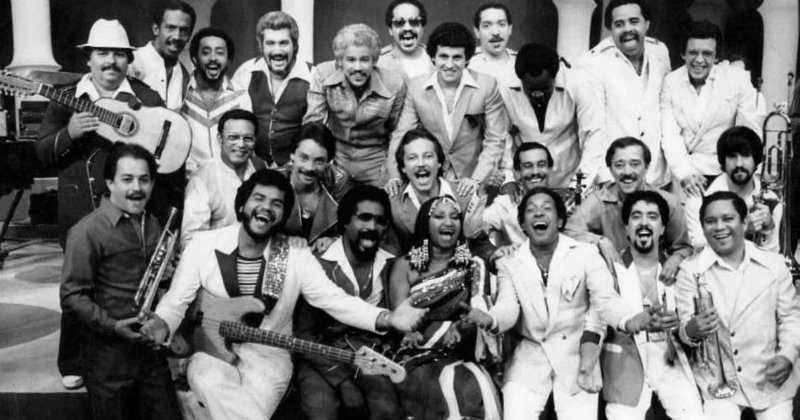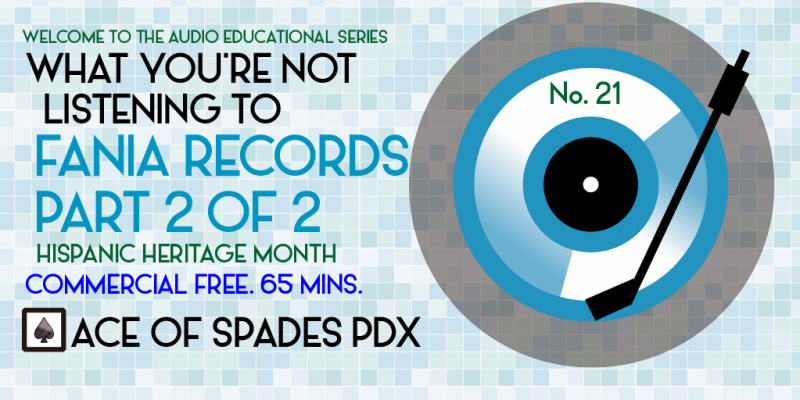Podcast: Play in new window | Download | Embed
Happy Hispanic Heritage Month! #fania #hispanicheritagemonth #latinx

Welcome to our second hour of amazing music from the classic Fania archives. For those of you who missed the first program, you can link to it here. Additionally, based upon the numerous requests I received about the first program, I am including the historical bio information I research with each show below this section for both programs.
“Salsa is not a rhythm, it’s a concept.”
Willie Colon
First Part
- Saona, Manuel Sanchez Acosta
- Te Estan Buscando, Rubén Blades
- Rat Race, Ralfi Pagán
- Amor Y Tentacion, Sophy
- Acere Bonco, Típica ´73
- Lamento De Concepción, Tite Curet Alonso
Second Part
- Rush Hour In Hong Kong, Louie Ramírez
- Volar A Puerto Rico, Willie Colón
- Times Are Changing, Jimmy Sabater
- Las Caras Lindas, Ismael Rivera
Finale
- Soy Guajiro, Fania All-Stars (live in San Juan, Puerto Rico, 1973)
- Quimbara, Celia Cruz & the Fania All Stars (live in Zaire, Africa, 1974)
Ben “Bear” Brown Jr., owner
Host, Producer, Audio Engineer and Writer
Artist/Song Info First Hour
PART ONE
Black Brothers, Tito Puente
Known often by his nickname, El Rey, or “The King, Puente was born in Spanish Harlem in New York, the son of native Puerto Ricans. A WW2 Navy veteran, he used his GI Bill to enroll in Juilliard. An expert percussionist, he was instrumental in bringing Latin music stateside in the 1950’s. His most famous composition is the song “One Como Va”, which was popularized by Santana in 1970.
Lluvia Con Nieve, Efrain “Mon” Rivera
There are actually two different men named Mon Rivera: Efrain, who is the more well known of the two, and his father, who was a janitor and songwriter in the plena genre, a Puerto Rican style of dance music. The younger Rivera, Efrain, who, in a send, have two careers: one in the 1950’s and 60’s as a bandleader on New York City, and a. huge career resurgence in the mid 1970’s on Fania after being rediscovered by bandleader Willie Colon.
The Bottle (La Botella), Joe Bataan
Still with us to this day, and still living in New Work City, his birthplace, he was a member of a street gang in his youth and did time for grand theft auto. Upon his release from prison, Bataan decided to get his act together and started the first of many ensembles he would front. This song is a cover of a track by spoken-word/freeform jazz artist Gil Scott-Heron.
The Oracle, Sabu Martinez
Blending and blurring the lines between Latin Salsa and Jazz music, Martinez actually played with some of the biggest and best known Jazz artists of the mid-20th century, including Dizzy Gillespie, Carlie Parker, Duke Ellington, Thelonious Monk, Charles Mingus, Lionel Hampton and countless others. Over a period of 16 years, he ended up recording 4 albums of material as bandleader.
Estoy Buscando A Kako, Charlie Palmieri
A self-taught pianist, Palmieri was considered the master of his chosen instrument in the Salsa genre. Prior to his recording for Fania, he often found steady work playing in larger ensembles and as a sideman for other artists. Some of these recordings are with Herbie Mann, and both men were signed to Atlantic Records, a label that was hitting its stride with Soul Jazz recordings in the mid-1960’s.
Bomba Na’ Ma’, La Lupe
Lupe Victoria Yolí Raymond was born in Cuba and released her debut album in 1961. Initially, La Lupe was not singed to Fania, but to a smaller Latin label, Tico, which was merged when the former bought the latter. Even though her star never shown as brightly as her eventual labelmate Celia Cruz, she is remembered for her powerful singing voice, intense and focused attitude on her performances and a wild style of dancing that had not been seen by a performer of Latin music prior.
Blanca, Johnny Pacheco with Pete (Conde) Rodriguez
Pacheco was born in the Dominican Republic but emigrated to New York City with his family when he was 11. Not only was he the co-founder of Fania records, he played with every single artist on the label, giving his help where people needed it. He, along with Condo Rodriguez, also founded the Fania All-Stars, and large Salsa band that would often back every artist on package tours, some that would fill stadiums in their heyday.
PART TWO
Tin Tin Deo, Ray Baretto
A conga drummer and bandleader. Baretto was one of the originators of the Salsa genre when it was still in its formation with the Latin styles of music called pachanga and boogaloo. Another long-time member of the Fania All Stars, he released almost 40 albums as a bandleader, including the Salsa classic Indestructible. He also was a well sought after session musician, playing with dozens of other top name artists in the Jazz field, including Weather report and Eddie “Lockjaw” Davis.
Lo Que Pide La Gente, Fania All-Stars
Founded in 1968 and named after the label they recorded for, interestingly, they ended up staying together s a recording and touring unit long after Fania had closed. They, along with much of the roster of the label, were a major concert draw, and the first artists of hispanic origin to play to stadium sized crowds around the world. One of their performances, in Africa, no less, drew 80,000 people, and was featured in the film Soul Power.
Cucula, Celia Cruz
Though already a star in her own right in homeland of Cuba by the end of the 1950’s, she, along with many others, fled the country when Fidel Castro took power. Starting her career all over again in Miami and then New York City, she toured with Tito Puente’s band for several years before her big break on the Fania label Vaya. Along the way, she became an icon for Latino women living in the United States and also became the best-selling Latin artist in history.
FINALE
Periódico De Ayer, Héctor Lavoe
A Puerto Rico native, our last artist was known as La Voz, or, the voice, was the male star who helped bring Salsa to massive worldwide acceptance while on the Fania label. Originally starting out as a member of Willie Colon’s band, his amazing and versatile voice, singing a series of songs about love, loss and relationships made him a huge star and a sex symbol, he would live the high life just a little too much: he was only 46 years old when he succumbed to HIV disease in 1993. This track was an international world-wide smash, and spent 16 weeks at number 1 in Mexico, a country that didn’t even have a Salsa scene in it.
Artist/Song Info Second Hour
PART ONE
Saona, Manuel Sanchez Acosta
A songwriter held in high regard, the profession of our first artist in this program originally studied medicine, became a doctor, and eventually relocated to New York City, where he was a traveling physician to many in the rest end. He traveled extensively, about six months out of the year, to work with other Salsa moccasins, any of them associated with Fania.
Te Estan Buscando, Rubén Blades
A man of many talents, Panamanian born Blades is not only a musician, but a songwriter, an actor in many U.S. film productions and even holds a law degree from Harvard. He even ran for president of his home country in 1994, winning 17% of the popular vote there.
Rat Race, Ralfi Pagán
Pagan, born in the Bronx to Cuban and Puerto Rican parents, released only five albums worth of material during his short recording career. A singer best known for soulful ballads in Spanish and English, he was murdered while on tour in Columbia in 1978, and it remains unsolved to this day.
Amor Y Tentacion, Sophy
Born in the northwestern Puerto Rican city of Aguadilla, Sophy Hernadez Font got her big break in New York City singing with Tito Puente’s band. Though not as well known as her Fania label mates, her recorded output consists of over 30 albums, with her best known work in the form of ballads.
Acere Bonco, Típica ´73
Known for their experimental style, Típica 73 was formed from members of Ray Baretto’s backing band. By the end of the decade, however, most of the original members had left due to creative differences, with some of them forming a new group, Los Kimbos.
Lamento De Concepción, Tite Curet Alonso
One of the most prolific writers of music in any genre, Alonso is credited with written over 2,000 compositions. Many of the songs in these two hours of programs were actually written by him. He recorded infrequently, and didn’t get his big break until after living in the United States for decades, working for the U.S. Postal Service.
PART TWO
Rush Hour In Hong Kong, Louie Ramírez
A man with a long history in Latin Jazz, Ramirez was a bandleader, vibraphonist and a songwriter. He became a staff producer in the mid-1970’s at Fania, and was so influential in the overall sound of the music coming from the label’s artists he has been called the “Quincy Jones of Salsa”.
Volar A Puerto Rico, Willie Colón
Not only a well-respected musician and bandleader, Colon also has been very active politically, even running for public office in his hometown of New York City. He released his first album in 1967 at the age of 17 on Fania, entitled El Malo. Jerry Masucci, one of the founders of Fania, brought in vocalist Hector Lavoe for Colon’s debut.
Times Are Changing, Jimmy Sabater
Much like La Lupe, Sabater was originally signed to Tito Records when bought out by Fania. Another native New Yorker, he was the leader of a popular band during the 50’s and 60’s, the Joe Cuba Sextet, which at one time d include singer and composer Cheo Feliciano.
Las Caras Lindas, Ismael Rivera
Prior to being a songwriter and percussionist, Puerto-Rican born Rivera actually was going to follow in his father’s footsteps and become a carpenter. After a failed attempts tempt at being a U.S. serviceman (he was discharged for not being fluent in English), he joined Orquesta Panamericana, and many of his compositions became huge hits.
FINALE
Soy Guajiro, Fania All-Stars (live at Yankee Stadium, New York City, 1973)
Quimbara, Celia Cruz & the Fania All Stars (live in Kinshasa, Africa, 1974)
And finishing off the second hour of our two hour series of programs is one of the greatest ensembles ever to grace stages around the world. These are two different selections, the first from Live at Yankee Stadium in 1973, which the Library of Congress inducted into its National Recording Registry, and the second features lead vocals by Celia Cruz, playing in Kinshasa, the capital of the Democratic Republic of the Congo in 1974, to their biggest audience ever.
“Copyright Disclaimer Under Section 107 of the Copyright Act 1976, allowance is made for ‘fair use’ for purposes such as criticism, comment, news reporting, teaching, scholarship, and research. Fair use is a use permitted by copyright statute that might otherwise be infringing. Non-profit, educational or personal use tips the balance in favor of fair use.”
